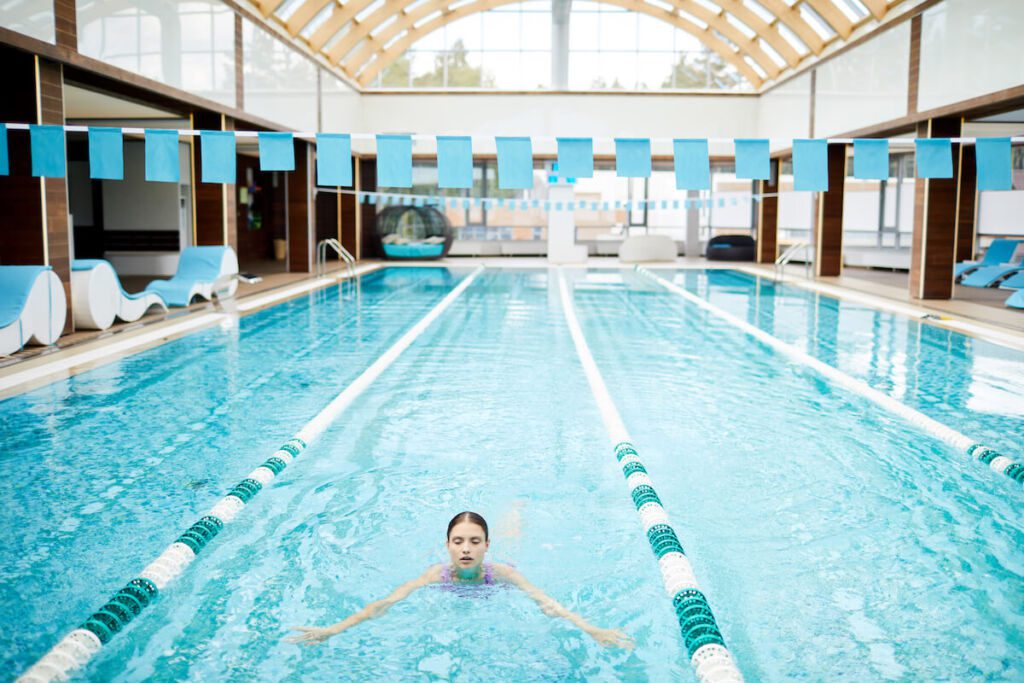Whether you’re an aquatics director looking to simplify operations or just looking for a healthy place to swim, a facility’s pool sanitation system is key for creating an enjoyable swimming environment that’s easy to operate. With so many options to choose from, it’s vital to find a sanitation system that can handle the size and needs of your aquatics facility.
Whether it’s treating a spa, olympic-sized competition pool or water park, an aquatic facility sanitation system’s role is to keep the water clean, clear and healthy for swimmers and staff. But, not all pool sanitation systems have the same impact on a facility’s day-to-day operations, toxic chemical use, health protection, air quality, swimming experience or overall bottom line.
To help you find the pool sanitation system that best fits your or your aquatic facility’s needs, let’s take a look at the pros and cons of today’s top six aquatics facility sanitation options: primary chlorine, salt water, UV, ozone, Ozone + UV AOP and Hydroxyl-Based AOP (Advanced Oxidation Process).
The Difference Between Primary and Supplemental/Secondary Pool Sanitation
But first, before we talk about sanitation systems, we have to talk about the difference between primary and supplemental/secondary pool sanitation. In short, supplemental or secondary sanitation systems are installed in addition to an aquatic facility’s primary pool sanitation method, like chlorine or bromine, which are required by health code. The Center for Disease Control and Prevention’s (CDC) Model Aquatic Health Code (MAHC) recommends that public pools use both primary and supplemental/secondary sanitation to reduce risk of recreational water illness (RWI) and avoid over chlorination. Supplemental or secondary pool sanitizers essentially take care of what primary chlorine or bromine primary sanitizers alone can’t, like protecting against chlorine-resistant RWIs, like Cryptosporidium. So, the use of both primary and supplemental/secondary sanitation are essential for providing healthy water and air quality for swimmers and staff.
Primary Chlorine Pool Sanitation
As mentioned, health codes require primary chlorine or bromine sanitation in all commercial aquatic facility water. Chlorine can handle all sizes of aquatic facility water and is convenient to use. As a primary sanitizer, chlorine serves as the first line of defense for secondary or supplemental sanitation. However, treating a pool with only chlorine creates risk for chlorine-resistant RWIs and chlorine-related health issues. When chlorine reacts with organic materials, like lotion, sweat, etc., it creates harmful combined chlorine, or chloramines, and other types of disinfection by-products (DBPs). These DBPs can cause red eyes, asthma, allergies, dry skin, lung irritation, Lifeguard Lung and other health issues. While chlorine is typically inexpensive to use, recent chlorine shortages have made it expensive and harder to find, especially in large quantities.
Salt Water Pool Sanitation
Saltwater pool sanitation systems have become popular among aquatics facilities because they produce chlorine without irritating swimmers’ skin. One of the most common misconceptions about saltwater pool systems is that they do not use chlorine. When in fact, saltwater pool systems produce chlorine using a different method, called electrolysis, which generates chlorine using salt cells.
While saltwater systems may be preferable for patrons, they can still have many of the same unpleasant side effects that traditionally chlorinated pools have and are not ideal for people with chlorine sensitivities. Additionally, saltwater pool systems can operate with lower toxic chemicals levels than traditional chlorine sanitation. Saltwater systems can be expensive and are complex to maintain, requiring experienced technicians even for minor problems. Facility operators should take all of these factors into account when deciding whether to install a saltwater pool system.
UV Pool Sanitation
UV (ultraviolet) pool systems are a traditional supplemental or secondary sanitation choice for aquatic facilities. Due to the wide-spread knowledge about UV sanitation technology in the pool industry, UV is a common choice for facilities. UV pool systems work by flowing pool water over a UV lamp that denatures bacterial DNA in the pool water passing over it. UV pool systems add power to primary chlorine sanitation destroying chlorine-resistant microbes and other contaminants. With additional supplemental or secondary sanitation protection, UV pool systems can also reduce the use of chlorine and other chemicals.
Even though UV systems are well known, they do have operational disadvantages for aquatics facilities. UV pool systems can sanitize water, but they can’t oxidize water. Without oxidation power, UV pool sanitizers don’t keep water as clear and can’t destroy all the unwanted contaminants that other supplemental and secondary sanitizers can. Additionally, UV pool systems require expensive installations, professional servicing, complicated lamp maintenance and use a high energy demand. Due to these disadvantages, UV pool sanitation systems are not the best choice for aquatic facilities with limited time, staff and budget.
Ozone Pool Sanitation
Another traditional choice for supplemental or secondary sanitation in aquatic facilities is ozone pool systems. Ozone pool sanitizers work by injecting ozone (O3) gas into the pool plumbing to oxidize pool water contaminants and chlorine-resistant microbes. With stronger oxidation power than chlorine, ozone pool systems allow some aquatic facilities to reduce chlorine consumption. Similarly to salt water pool systems, ozone pool systems can make pool water feel softer.
While ozone pool sanitation systems are a common water treatment method, their sanitation power is limited to smaller bodies of water. Typically, you won’t find ozone pool systems on larger bodies of water with high bather loads, like water parks or competition pools. Additionally, ozone pool systems are difficult to install and maintain because ozone is hazardous, corrosive and requires degassing to protect swimmer safety, equipment and pool surfaces.
Hydroxyl-Based AOP Pool Sanitation
Using a patented technology, Hydroxyl-Based AOP pool sanitation systems create high amounts of hydroxyl radicals without ozone or required degassing, unlike ozone or UV+ozone AOP systems. Hydroxyl radicals are the most powerful oxidative compound available for recreational water treatment. Since these hydroxyl radicals are non-corrosive, using a Hydroxyl-Based AOP pool sanitation can extend the life of your pool surfaces and equipment. Hydroxyl-Based AOP systems deliver the healthiest possible water to patrons while helping operators improve efficiency. Independent aquatic facility case studies have shown that Hydroxyl-Based AOP pool sanitation systems can reduce DBPs by up to 90 percent, while allowing pools to reduce up to 30 to 50 percent of chlorine use and chemical costs.
With so many options available, selecting the right aquatic facility sanitation method can seem like a daunting task. But, your search can be narrowed down by choosing a sanitizer that fits you aquatic facility’s needs for cost, efficiency, health protection and time.
Interested in saving money by reducing chlorine use at your aquatics facility? Take a look at our blog, “How Low Can You Go? 3 Ways To Lower Combined Chlorine In Swimming Pools.”
Gabrielle Palumbo
Marketing Director



